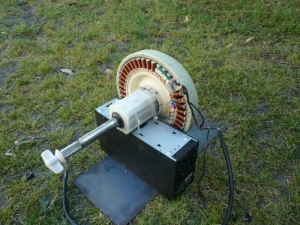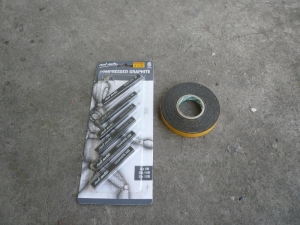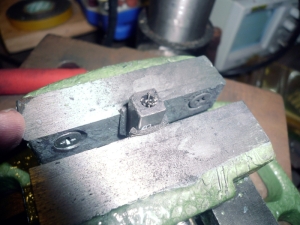This is a little side project I’ve been working on over the last few days. I’ve wanted to build a solar cooker for a while now, so when the opportunity came up to score this Ku Band satellite dish for free, I couldn’t resist myself. These dishes aren’t perfectly circular, but more elliptical, because they are designed to be the cut out of a circle projected onto a parabolic surface but slightly off to one side of it from centre. In this way, the horn that contains the receiver and transmitter is not in the way of the incoming signal. Hence, you get more surface area to collect the signal but, more importantly, you don’t get weird effects, like scattering, degrading the incoming signal.

Ku Band Satellite Dish with Stand
The first thing to do was to go into work and grab some aluminium tape and get cracking. I cleaned the surface first of course.

The aluminium tape I used

First strip on
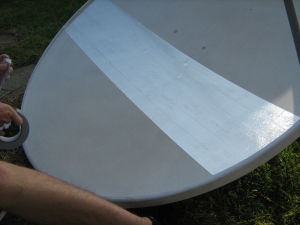
Curvature begins to be a problem
At this point the curvature of the dish starts to cause a fair bit of ripples in the tape, it also begins to get harder to line up the tape for a straight run across the dish. So, I changed to applying the tape vertically, in line with the major axis, instead of horizontally, in line with the minor axis.
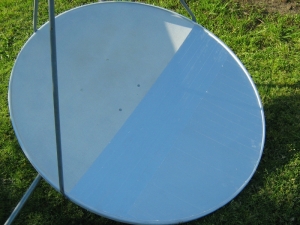
Halfway there.

My five year old taking a photo of me whilst I am working. He does love cameras.

The dish with the reflective surface finished
As you can tell from this photo, obviously mirrors would have better reflectivity. But, I don’t really feel like cutting that many square pieces of mirror and then attaching them to the dish. This was much easier and will get a similar result cooking wise. If I were building a solar powered metal foundry, as at one point I have planned to, then I would rethink my choice.
After this, I removed the horn and then flipped the mount on the back of the dish around. I did this so I could have the focal point above the dish, instead of in front of it. That way I would get the sun light concentrated onto the bottom of my cooking pot, instead of on the side, which will allow for more even cooking.
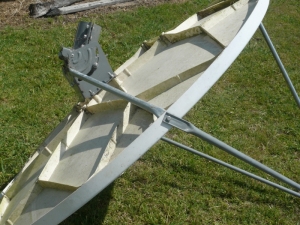
Dish mount in original direction

Dish mount in new direction
Next, I tied a rope between the main boom of the stand, that came with the dish, and one of the support legs because I had problems with it sliding out when I tried to mount the dish on it.
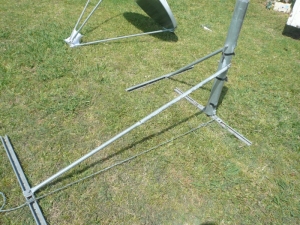
The stand that came with the dish

The dish is all mounted and ready to go
Once it was all together, I had a little bit of fun with a piece of paper. The reflector didn’t have enough power to burn through plain white paper. But, if you put a black dot on it, using a permanent marker, then it catches on fire pretty much straight away.

*insert evil laugh here* IT WORKS!!!
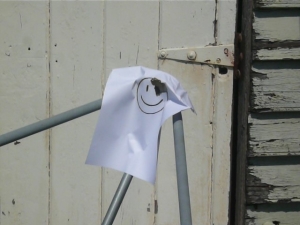
I can’t believe he’s still smiling after that.
After I had my bit of fun, I attended to the problem of being able to hold a pot at the focal point. I ended up using a section of wire fencing I had laying around for my initial tests but I may end up making a hanging arrangement later on. This is because I’m not too sure how it will go during late afternoons or early mornings when the Sun is lower in the sky. All the contents may shift to one side and spill out. That will be one test for a later date.
All I had to do to mount the cooking rack was take off the coupler that is used to hold the horn and the three support legs together. Then slide the poles through the holes in the rack, then re-attach the coupler. With this set up, the rack is held in place very well by the support poles attached to the minor axis, but moves a bit up and down on the pole attached to the major axis. This may actually help in the long run, as it will allow for a little bit of adjustment when trying to make the cooking pot level.
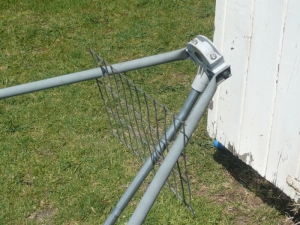
Cooking rack installed
I then did a test to see how long it would take for the cooker to heat up 500mL of water in the pot I bought ages ago just for this purpose. I got the pot in a set of two for AUD$5 from a local clearance store. Mainly because they were cheap and had a black enamel coating on the bottom. This greatly enhances the effectiveness of a solar cooker due to the black absorbing more of the incoming radiation and, hence, transferring it into more heat energy for cooking.

Solar cooker aligned and with cooking pot in place.
The pot only just fits in between the support poles and required a little bit of wriggling to persuade it into place. You can see the yellow thermocouple I used to measure the temperature of the water in this picture. At the end of the experiment, I realised that either the thermocouple isn’t very accurate at measuring temperature, or the multimeter I used it with isn’t. Because, when the water was happily boiling away, I was getting a reading of only 97.6 degrees centigrade not the 100 degrees that I was suppose to be getting.

500mL of water boiling vigorously.
It only took approximately 14 minutes to get the 500mL of water to fully start boiling. So, I call this a massive success. I can’t wait to see how this thing performs in the middle of an Australian summer.
After I finished testing, I took a measurement of the ambient air temperature with my multimeter and compared it to the reading from my cheap wireless weather station that I was using for timing. The weather station took a reading of 29.2 degrees C whilst the multimeter took a reading of 24.8 degrees C. Considering my weather station is one of the cheapest available, with only indoor and outdoor temperature readings as well as humidity and barometric pressure, I don’t think it is giving a very good reading either. But it does illustrate the inaccuracies that I didn’t foresee at the start.
Anyway, here is a plot of the data I acquired during testing and a copy of the spread sheet I wrote up to go along with it.
One thing I did notice is the linearity of the plot. I must admit that I was expecting it to trail off at the end but it didn’t. This would imply to me that this thing has a lot more potential for heating up more things then just water. I’m going to try and find a carbon brick from somewhere and heat that up. That should give me a real idea of its true power.

Plot of the time it took for 500mL of water to reach full boil.
Water Boil Test
I think I’m going to have a bunch of fun with this in the future.






